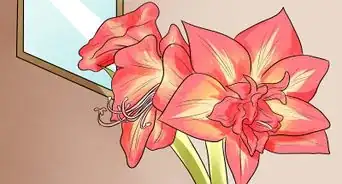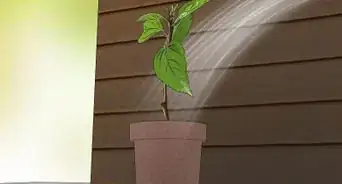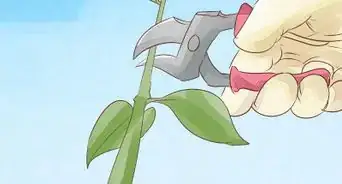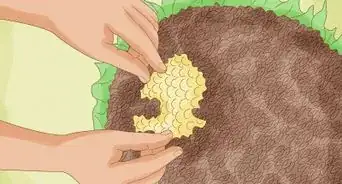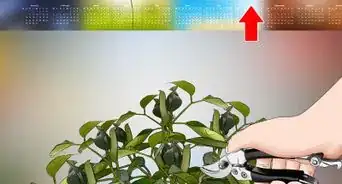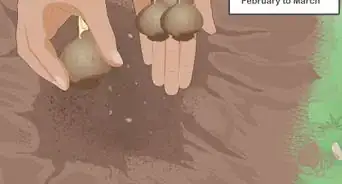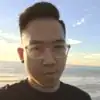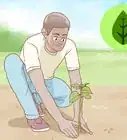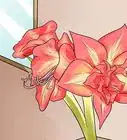This article was co-authored by Chai Saechao. Chai Saechao is the Founder and Owner of Plant Therapy, an indoor-plant store founded in 2018 based in San Francisco, California. As a self-described plant doctor, he believes in the therapeutic power of plants, hoping to keep sharing his love of plants with anyone willing to listen and learn.
There are 9 references cited in this article, which can be found at the bottom of the page.
wikiHow marks an article as reader-approved once it receives enough positive feedback. This article received 13 testimonials and 88% of readers who voted found it helpful, earning it our reader-approved status.
This article has been viewed 283,585 times.
Using seeds is a cost-effective way to grow flowers. You can start growing flower seeds indoors, in a planter, or outside in your garden or flower bed. Moisture, sunlight, and the proper soil are the most important components to growing a flower from a seed. Once the seedling becomes a flower, you should care for it like you would any other flower.
Steps
Planting Seeds Outside
-
1Till the soil before planting the seeds. Use a rake, tiller, or pitchfork to dig 6–8 inches (15–20 cm) under the soil. Turn the soil over until you’ve loosened all the soil in your flower bed.[1]
- You may also want to incorporate compost into the soil to promote flower growth.
-
2Sprinkle or bury the seeds, per the instructions. The information on the seed packet will explain if the seeds have any special germination needs. Soft-shelled seeds should be pressed lightly into the soil, while hard-shelled seeds should be completely covered with soil. Read the instructions to see which method you should use.[2]Advertisement
-
3Mark the planting area so you know where you planted the seeds. This is useful when planting a wide variety of seeds or plants. The visual reminder will also let you know whether the flowers are growing or if your seeds failed to germinate.[3]
- Not all seeds will become flowers.
- Labeling will also prevent you from mistaking your seedlings for weeds.
-
4Mist the seedbed to keep the soil moist. Lightly mist your flowerbed with water so that the soil is moist. The soil should always be moist while the seeds are germinating. To see whether the soil is actually moist, press your finger down into your flowerbed. If the soil feels dry under the surface, you know you need to water your seeds.[4]
-
5Wait for your flower(s) to germinate. The flowers should germinate within 3 weeks to a month. If you don’t notice that they are starting to grow, you may have to lay down more seeds.[5]
-
6Water your flowers. If it rains, you shouldn't have to water your flowers. However, it's important the soil under the flowers stays moist. If you have a period of time with no rain, water them so that the top 6–8 inches (15–20 cm) remains moist.[6]
-
7Prune dying flowers and leaves. Pruning the flowers after they have bloomed will encourage new growth. Use a set of hand pruners and clip away old or damaged flower petals or leaves.[7]
-
8Use fertilizer if desired. An organic fertilizer will promote the health of your flowers and brighten their color. Look for a fertilizer designed for your specific type of flower, and sprinkle it on the surrounding soil. Read the instructions before to avoid over-fertilizing, which can lead to the flowers dying.[8]
- A balanced 5-10-10 fertilizer can be used on the widest variety of flowers.
Germinating Seeds Inside
-
1Get a container that has drainage holes in it. If you want to grow multiple flowers, you can purchase an indoor planter that has spaces for more than one flower. It’s important that the container has drainage holes because overly saturated soil will inhibit the seed’s growth.[9]
- If you don’t want to buy a planter, you can punch holes in the bottom of an egg carton and use that instead.
- Put a rag or cloth under the container to prevent leaks.
-
2Fill each section with a mixture of peat moss, vermiculite, and perlite. Combine the three different types of soils together in equal parts to create a well-drained soil high in organic material. Pour your flower container ¾ of the way up with this mixture.[10]
-
3Bury or sprinkle the seeds on top of the soil, depending on their species. Harder seeds should be covered with organic material like vermiculite or sphagnum moss, while softer seeds should lay on the top of the soil. Read the seed packet that came with your seeds to determine if you should bury them under the soil or leave them on top of it.[11]
-
4Water the seeds. Lightly sprinkle water on top of the soil, but don’t add too much or you could wash away smaller seeds. You can do this by sprinkling the water with your hand, or slowly pouring the water into the container from a small saucer. Either way, the soil should be moist but the seeds should still be intact.[12]
-
5Cover the container with plastic wrap. Plastic wrap or a sealed lid will trap moisture and help the seeds germinate. Poke a couple of holes in the top of the plastic wrap so that the plant can breathe.[13]
- You can also wrap the planter in a plastic bag for a similar effect.
-
6Move the planters to a warm area of the house. Germinating seeds do best in temperatures of 65–75 °F (18–24 °C). Move the planter to a warm area that gets plenty of sunlight. Alternatively, you can place the planter on an artificial heat source, like the top of a refrigerator or near the oven.[14]
- Move the planter before you use the oven or heat could damage the seeds.
-
7Harden off the seedlings if transplanting them outside. If you plan on transplanting your seedlings outdoors, harden them off by leaving them outside under a shaded area for 7-10 days. This will acclimate them to the change in temperature. Some flowers have an intolerance for the cold and should be kept indoors. [15]
- The seed package should give you a range of temperatures in that the flower will thrive.
- If a flower is cold-resistant, it should be labeled as hardy.
- Tender flowers are less resistant to cold and should always be in an area that’s over 40 °F (4 °C).
-
8Transplant the seedlings outside, if desired. Position a small spade 2–3 inches (5.1–7.6 cm) away from the seedling. Gently dig around the seedling, making sure not to sever any of its roots. Then, pull the seedling out of the planter, with the soil around its roots, and place it in well-drained soil in your garden.[16]
- Monitor the seedlings to make sure that they don't die after the transplant.
Expert Q&A
Did you know you can get expert answers for this article?
Unlock expert answers by supporting wikiHow
-
QuestionWhat does it mean if a flower's roots stick out of the soil?
 Chai SaechaoChai Saechao is the Founder and Owner of Plant Therapy, an indoor-plant store founded in 2018 based in San Francisco, California. As a self-described plant doctor, he believes in the therapeutic power of plants, hoping to keep sharing his love of plants with anyone willing to listen and learn.
Chai SaechaoChai Saechao is the Founder and Owner of Plant Therapy, an indoor-plant store founded in 2018 based in San Francisco, California. As a self-described plant doctor, he believes in the therapeutic power of plants, hoping to keep sharing his love of plants with anyone willing to listen and learn.
Plant Specialist
-
QuestionWhat month should you plant flower seeds?
 Maggie MoranMaggie Moran is a Professional Gardener in Pennsylvania.
Maggie MoranMaggie Moran is a Professional Gardener in Pennsylvania.
Home & Garden Specialist
-
QuestionWhat are the easiest flowers to grow from seed?
 Maggie MoranMaggie Moran is a Professional Gardener in Pennsylvania.
Maggie MoranMaggie Moran is a Professional Gardener in Pennsylvania.
Home & Garden Specialist
References
- ↑ https://www.bayeradvanced.com/articles/direct-sowing-starting-seeds-outdoors
- ↑ https://parkseed.com/sowing-seeds-outdoors/a/hand20/
- ↑ https://www.bayeradvanced.com/articles/direct-sowing-starting-seeds-outdoors
- ↑ https://parkseed.com/sowing-seeds-outdoors/a/hand20/
- ↑ https://parkseed.com/sowing-seeds-outdoors/a/hand20/
- ↑ https://garden.org/learn/articles/view/1284/
- ↑ https://garden.org/learn/articles/view/1284/
- ↑ https://www.onehundreddollarsamonth.com/how-to-maintain-a-healthy-flower-garden/
- ↑ https://www.gardeners.com/how-to/perennials-from-seed/7530.html
- ↑ https://www.bhg.com/gardening/flowers/perennials/growing-perennials-from-seed/
- ↑ https://www.gardeners.com/how-to/growing-annual-flowers-from-seed/5663.html
- ↑ https://www.bhg.com/gardening/flowers/perennials/growing-perennials-from-seed/
- ↑ https://www.bhg.com/gardening/flowers/perennials/growing-perennials-from-seed/
- ↑ https://www.almanac.com/content/starting-seeds-indoors
- ↑ https://www.bhg.com/gardening/flowers/perennials/growing-perennials-from-seed/
- ↑ https://youtu.be/ObUGfdGqSwo?t=5m33s
- ↑ https://www.gardeners.com/how-to/perennials-from-seed/7530.html
About This Article
To grow flowers from seed, fill a planter with a mixture of peat moss, vermiculite, and perlite and sprinkle the seeds on top. Water the seeds, cover the planter in plastic, and put it in a warm location indoors. Once the seeds sprout, thin out the seedlings and plant them outdoors after all danger of frost has passed. You can also sow your seeds directly into the soil outdoors, but germinating them inside gives your flowers a stronger start! For more tips on sowing seeds outdoors, read on!



















